Imagine biting into warm, fresh bread and feeling instantly comforted. It’s a moment that can remind us of family or cozy evenings. Now, think about making that moment even better with a splash of vanilla. Vanilla makes homemade bread smell and taste inviting and nostalgic. Discover how vanilla can transform your bread recipes. It can make your baking more enjoyable, touching both the senses and the heart.
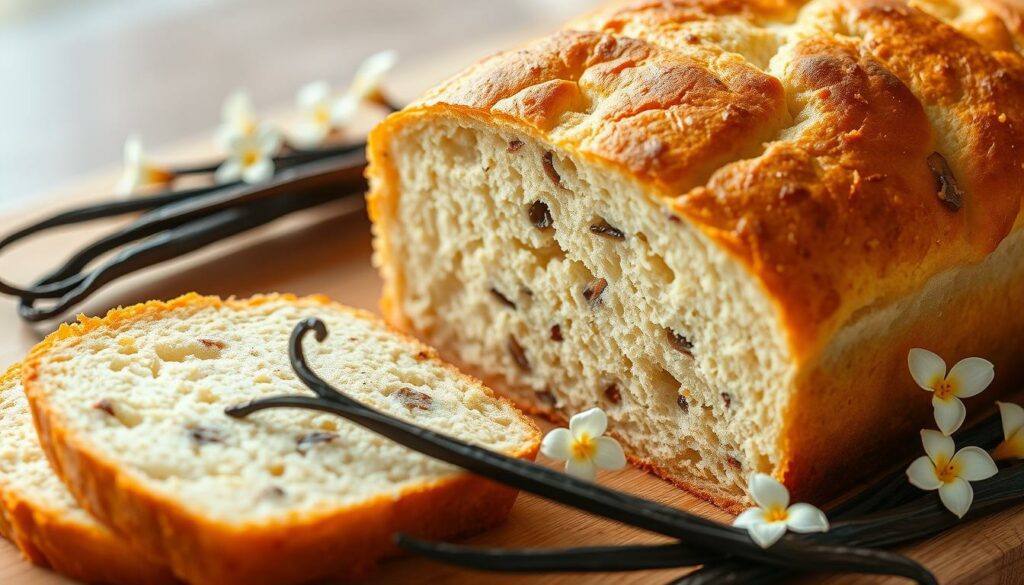
Table of Contents
The Role of Vanilla in Baking
Vanilla is key for making your baked goods taste better. It adds a special touch to bread, enhancing the flavor. Adding vanilla to both sweet and savory dishes transforms them.
Understanding Flavor Profiles
Vanilla is crucial in creating deep flavors in baking. It enriches the taste, blending well with sweet ingredients. Common uses of vanilla include:
- Sweet breads like brioche and challah
- Cakes and pastries
- Chocolate products, where it enhances the overall flavor
Vanillas from different places, like Madagascar, add unique flavors to dishes. Using pure vanilla extract gives a better taste. Sometimes, imitation vanilla works too, especially in recipes with stronger tastes. The right amount of vanilla boosts sweetness perfectly without being too much.
Common Uses of Vanilla in Baking
Vanilla is perfect in sweet breads, improving the taste of eggs and sugar. It’s versatile and can replace other flavors. Choose pure vanilla for a deeper flavor in your baking. Vanilla makes even simple recipes stand out.
The right quantity of vanilla is important. About half a teaspoon per loaf of bread is a good start. Adjust it to fit your taste. Using vanilla can make exploring new recipes exciting and enrich their flavors.
For more tips on using vanilla well, check out this resource for great advice.
Benefits of Adding Vanilla to Bread
Adding vanilla to your bread mixes taste with fragrance in a delightful way. It makes your baked goods more appealing. Vanilla improves the flavor and smells, making an average loaf special.
Enhancing Sweetness and Aroma
Vanilla plays a key role in making bread both sweeter and more aromatic. It blends with other ingredients, improving the bread’s overall flavor. You’ll find that vanilla can make the bread’s sweetness more noticeable, enhancing each bite.
This is particularly true for sweet breads. A little vanilla can take the taste to the next level.
Creating a Signature Flavor
Using vanilla in your bread can give it a distinct flavor that stands out. Its rich, warm taste can leave a memorable impression. If you want to wow your guests or enjoy a special treat, try adding vanilla.
What Happens If I Add Vanilla to a Bread Recipe
Adding vanilla to a bread recipe can really take your baking to the next level. It doesn’t just make things taste better, but also changes how the bread feels and stays moist. Let’s dive into how vanilla affects the texture and moisture of bread.
Impact on Texture and Moisture
When you put vanilla in your bread, the crumb becomes softer and more welcoming. Vanilla’s natural oils bring in moisture, helping the bread stay fresh longer. This extra moisture works with the yeast, making the bread tender all through.
Balancing Flavors in Your Bread
Vanilla is key for getting flavors right in bread. It can make the sweetness of sugar pop, without taking over. Its subtle floral hints mix well with spices, making the bread’s taste full and rich.
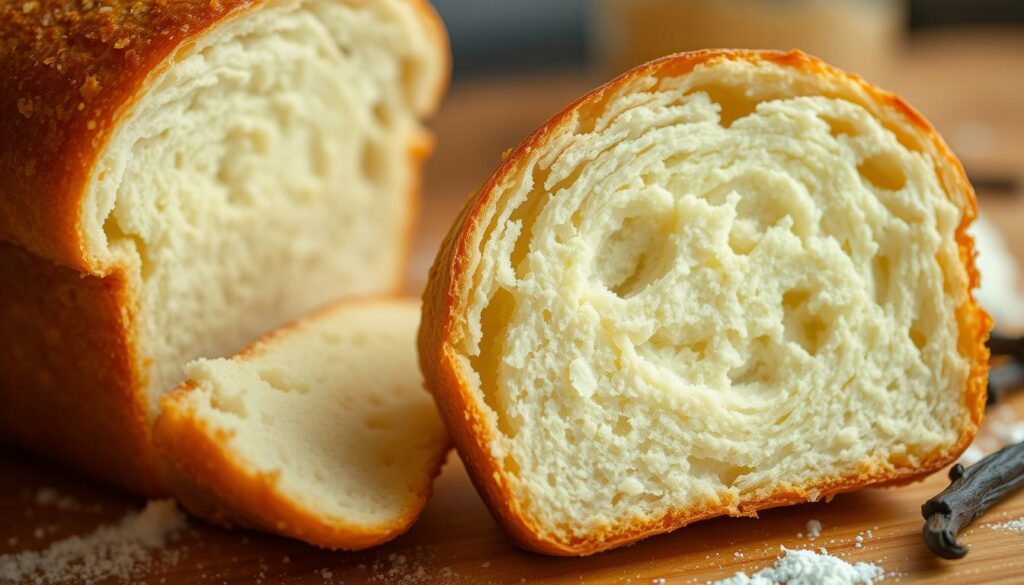
| Aspect | Before Adding Vanilla | After Adding Vanilla |
|---|---|---|
| Texture | Crusty, dense | Soft, moist |
| Moisture Level | Potentially dry | Increased hydration |
| Flavor Profile | Single-note | Balanced, enriched |
By using vanilla in your bread, you get better texture and taste. You can adjust the vanilla to suit your preferences. This makes baking an exciting and fulfilling activity every time.
Types of Vanilla to Use in Bread Baking
Choosing the right type of vanilla can make your bread baking better. There are many kinds to pick from, each with its own special taste and benefits. Knowing the differences helps you pick the best vanilla for your bread and sweet breads.
Vanilla Extract vs. Vanilla Paste
Vanilla extract is popular and used a lot in baking. It comes from quality vanilla beans. The slow extraction keeps its rich flavors. Madagascar vanilla is loved for its creamy, sweet taste.
Vanilla bean paste is also loved by many. It has the strong flavor of extract but also has real vanilla specks. This means your dishes not only taste great but look great too. You can switch vanilla paste and extract without changing the recipe. This makes your bread creamier.
Using Vanilla Sugar for Sweet Breads
For those liking sweeter bread, vanilla sugar is a great choice. It mixes vanilla flavor with your bread, making it sweet and smelling great. It’s perfect when you need something a little sweeter. It makes your baked goods taste even better.
Trying different vanillas can change your bread recipes. Using top-notch vanilla extract or paste gives your bread an amazing taste. Vanilla sugar brings sweetness. Your bread won’t just be basic; it will be unforgettable.
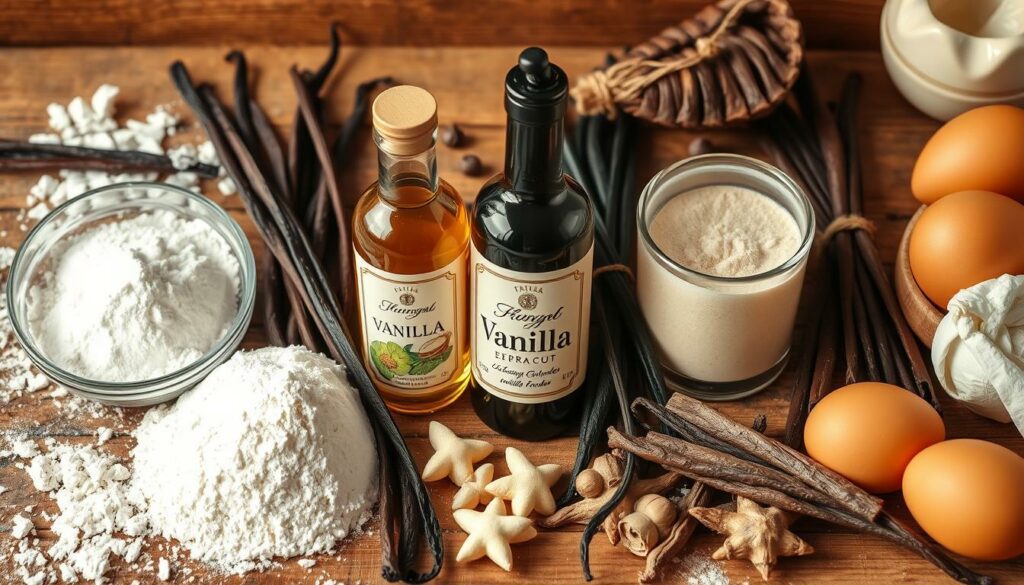
How to Incorporate Vanilla into Your Bread Recipe
Adding vanilla to your bread can greatly improve its taste. It’s important to know how to do this right. We will look at how to measure vanilla properly and when to add it. These tips will help make your bread taste amazing.
Measuring the Right Amount
Getting the vanilla amount correct is key to a tasty loaf. Use a teaspoon of vanilla extract or a tablespoon of vanilla paste for one loaf. Feel free to adjust the amount based on what you like.
Timing for Optimal Flavor Release
When to add vanilla is also crucial. Mix it in while making the dough for even flavor. This step ensures that as the dough rises and bakes, your bread will be filled with a lovely vanilla scent.
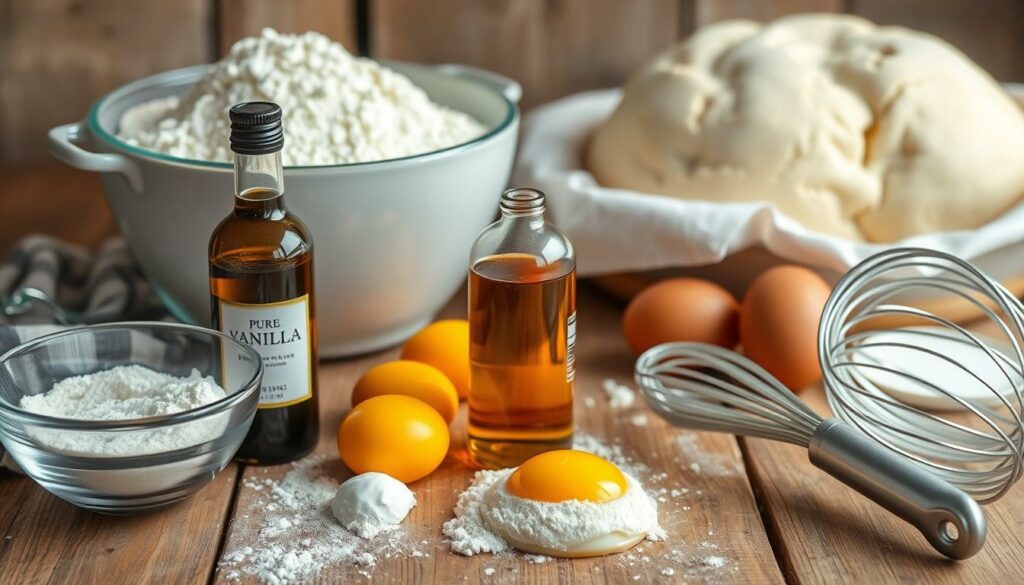
Common Mistakes When Adding Vanilla
Adding vanilla to your bread recipes can make them taste better. But, it’s important not to make common mistakes. These mistakes include using too much vanilla or picking low-quality products. Knowing about these errors can improve your baking a lot.
Overwhelming Other Flavors
Using too much vanilla is a common issue. It can hide the taste of other ingredients in your bread. This creates an unbalanced taste, with vanilla overpowering everything else. Stick to the recommended amount, which is usually ½ to 2 teaspoons per recipe. This helps to get the right mix of flavors.
Using Low-Quality Vanilla Products
Choosing poor-quality vanilla can make your bread taste bad. Most of the vanilla extracts sold are actually fake, missing the real vanilla’s rich taste. Low-quality products can give your bread a chemical flavor, not the delicious vanilla scent you want. To fix this, use high-quality extracts or pastes. Make sure they have at least 35 percent alcohol, as the FDA says. Vanilla paste is a good choice since it mixes extract with vanilla powder for a stronger taste.
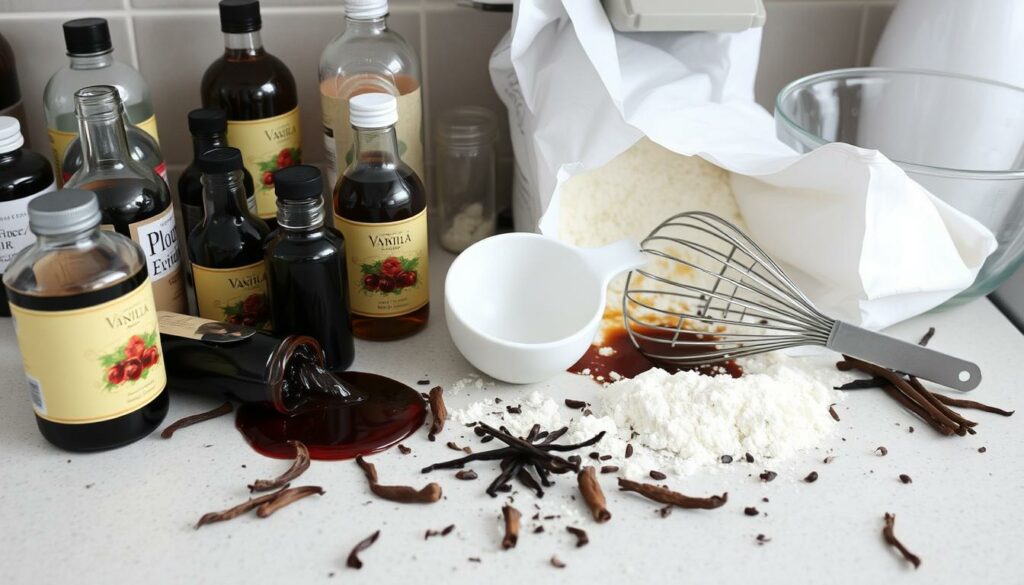
Recipes to Try for Bread with Vanilla
Trying out different bread with vanilla recipes can really lift your baking game. The sweet vanilla bread brings a warm, cozy vanilla flavor, making it great for any event. Vanilla-infused cinnamon rolls add a yummy twist to a well-loved classic. They blend cinnamon’s sweetness with vanilla’s deep flavors.
Sweet Vanilla Bread Recipe
This amazing sweet vanilla bread recipe shows how vanilla changes regular bread into something special. With the right stuff, you’ll make a soft, fluffy, slightly sweet loaf.
- Prep Time: 20 minutes
- Cook Time: 50 minutes
- Yields: 1 loaf (12 slices)
- Calories per Serving: 166
Here’s what you need for tasty sweet vanilla bread:
- 2 cups of all-purpose flour
- 2 ½ teaspoons of active dry yeast
- 3/4 cup of granulated sugar
- 1 1/2 teaspoons of vanilla extract
- 1/2 cup of unsalted butter, softened
- 1 cup of whole milk
- 2 eggs, at room temperature
- 1/4 teaspoon of salt
- Optional toppings: Blackberry-Nectarine Preserves, Raspberry Jam
To bake, first heat your oven to 350ºF. Mix the ingredients well, put the mixture in a loaf pan, and bake for 50-60 minutes. Let it cool down for at least an hour. This helps keep its texture.
Vanilla-Infused Cinnamon Rolls
For a mouth-watering treat, try vanilla-infused cinnamon rolls. These rolls mix cinnamon’s classic taste with vanilla’s cozy warmth. They’re an amazing choice for breakfast or dessert.
- Prep Time: Approx. 2 hours and 15 minutes
- Cook Time: 45 minutes
- Yields: 12 rolls
Important ingredients for these yummy rolls are:
- 3 ⅓ cups of plain flour
- 1 tsp of dried yeast
- ¼ cup of caster sugar
- 1 cup (250ml) of milk
- ½ stick (50g) of butter
- 2 egg yolks
Mix everything, shape the dough into three ropes, braid them, and let them rise. Bake at 425ºF for the first 10 minutes, then 400ºF for another 35 minutes. They will look gorgeous and taste fantastic with cream cheese frosting or fresh fruit preserves.
Both the sweet vanilla bread and the vanilla-infused cinnamon rolls are delightful ways to use vanilla in your baking. Enjoy making these classic goodies. Share them with family and friends to make any gathering more memorable.
Alternatives to Vanilla in Bread Recipes
While vanilla is a beloved flavor in many bread recipes, there are many other options. These alternatives to vanilla can bring new tastes to your baking. Try using spices, extracts, or sweet options for yummy variations.
Experimenting with Other Flavorings
Adding spices or natural flavors can really change up your bread. Here are some great substitutes:
- Almond Extract: It’s stronger than vanilla. Use just half the needed amount.
- Maple Syrup: Use the same amount as vanilla extract for sweetness.
- Honey: Swap one teaspoon of vanilla with one tablespoon of honey for a special taste.
- Baking Spices: Try nutmeg or cardamom as a replacement in your baking.
Combining Vanilla with Other Extracts
Mixing different extracts can create complex flavors. Adding other extracts with vanilla brings more depth:
- Coconut Extract: Gives a tropical feel when used with vanilla.
- Bourbon or Rum: These can taste like vanilla because of oak aging. Use two teaspoons for every teaspoon of vanilla.
- Vanilla-Flavored Plant-Based Milk: Swap it 1:1 with vanilla extract.
- Vanilla Sugar: Using vanilla sugar instead of regular sugar adds subtle vanilla flavors.
Trying these other flavorings in bread will let you explore new ideas in baking. Finding the right mix of extracts can make your recipes stand out, offering unforgettable tastes.
| Flavoring | Substitution Ratio | Notes |
|---|---|---|
| Almond Extract | 0.5 tsp = 1 tsp vanilla | Much stronger flavor |
| Maple Syrup | 1 tsp = 1 tsp vanilla | Sweet, unique flavor |
| Honey | 1 tbsp = 1 tsp vanilla | Rich sweetness |
| Baking Spices | 0.5-1 tsp = 1 tsp vanilla | Depends on spice strength |
| Vanilla-Flavored Milk | 1 tsp = 1 tsp vanilla | Great for plant-based recipes |
| Vanilla Sugar | 1 tsp = 1 tsp sugar | Subtle vanilla flavor |
Conclusion
Adding vanilla to bread enhances its flavor and smell greatly. You usually need 1/2 to 1 teaspoon of pure vanilla extract in a standard loaf for the best taste. For smaller bread like mini loaves or rolls, you might use 1/4 to 1/2 teaspoon. If you’re baking something big, 1 to 2 teaspoons might be better.
Vanilla does more than just add flavor to bread. You can use vanilla powder or paste to change up the sweetness. Using high-quality pure vanilla makes your bread taste amazing, even if it costs a bit more. If you’re watching your spending, buy vanilla in bulk or mix it with other spices to save money but keep the flavor.
Adding vanilla can make your bread a hit, whether it’s a rich banana bread or something new you’re trying. With the right approach, adding vanilla to your bread is easy. And it’s sure to impress everyone who tries it.
FAQ
What happens if I add vanilla to a bread recipe?
Adding vanilla to bread makes it taste and smell better. It gives a full flavor, making your bread stand out. Vanilla complements the sweetness in the bread too.
How does vanilla affect the texture of bread?
Vanilla makes your bread softer and more moist. This is because of the natural oils in vanilla.
What types of vanilla should I use for baking bread?
For baking, you can use vanilla extract, paste, or sugar. Vanilla paste gives a strong flavor and shows tiny vanilla specks. Vanilla sugar makes your bread sweeter.
How much vanilla should I add to my bread recipe?
Usually, a teaspoon of vanilla extract or a tablespoon of vanilla paste works well for a loaf of bread. It’s important to measure it right to keep the balance of flavors.
When should I add vanilla to my bread dough?
Add vanilla when you’re mixing your bread dough. This helps the flavor spread evenly as the dough rises and bakes.
What are common mistakes when using vanilla in bread baking?
A big mistake is adding too much vanilla, which can hide other tastes. Also, using cheap vanilla can make your bread taste fake.
What recipes can I try that include vanilla in bread?
Try making a sweet vanilla bread or vanilla cinnamon rolls. Both are great ways to enjoy vanilla flavor in baking.
Are there alternatives to vanilla I can use in my bread recipes?
Yes, you can use spices like nutmeg or cardamom, or citrus zests. Mixing vanilla with other extracts like almond or coconut also makes bread taste unique.

